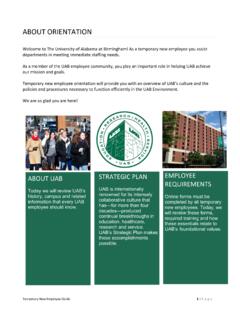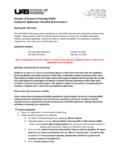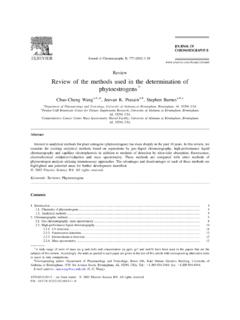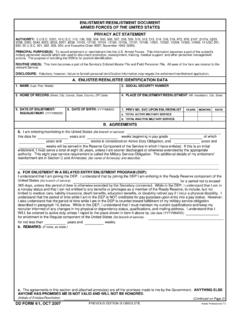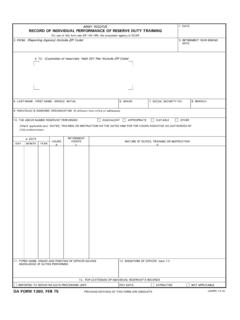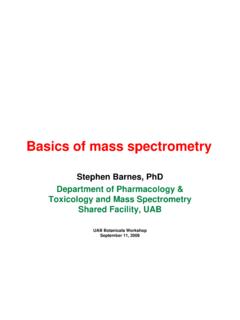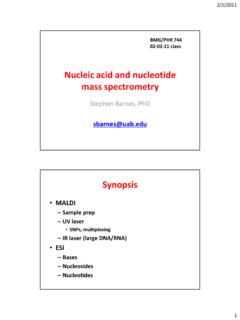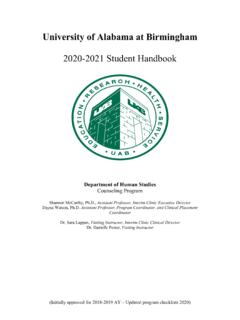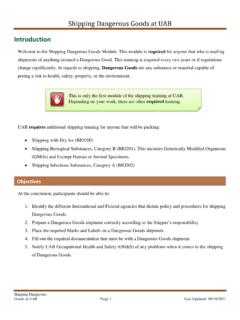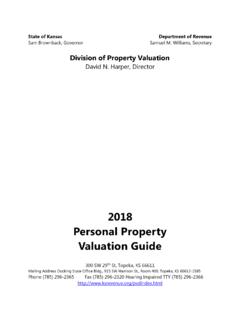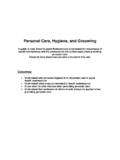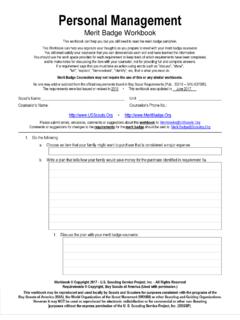Transcription of Personal Statement Makeover - UAB
1 Personal Statement Makeover : Workshop for NIH My Biosketch July 27th 2015 Jennifer L. Greer, PhD, UAB Graduate School, Professional Development Program (PDP) Carolina Kunnen, PhD, and Stephanie Wall, PhD, Post Doctoral Association (PDA) A little writing humor Agenda Time Action Presentation and lunch Quick write Peer review Discuss Writing, editing and coaching Challenge: Personal Statement (PS) Why is writing hard? Especially when it s about yourself? What if linguists could find patterns in academic texts like geneticists find patterns in DNA? These textual patterns might show how research stories are typically structured and written. EB examples: Introductions, Discussions, Abstracts, Review Articles, Summaries, & Short Research Reports Answer: Evidenced Based (EB) Model Step 1: Analyze NIH Personal Statement Instructions & sample Personal Statement texts Step 2: Create a Model Personal Statement Structure/Outline Step 3: Test the Personal Statement Model Step 4: Share the Personal Statement Model Step 5: Revise and test the Personal Statement Model again Our Action Research Project NIH Personal Statement Analysis Follow the instructions NIH My Biosketch Instructions Personal Statement Briefly describe why you are well-suited for your role in the project described in this application.
2 The relevant factors may include aspects of your training; your previous experimental work on this specific topic or related topics; your technical expertise; your collaborators or scientific environment; and your past performance in this or related fields (you may mention specific contributions to science that are not included in Section C). Also, you may identify up to four peer reviewed publications that specifically highlight your experience and qualifications for this project. If you wish to explain impediments to your past productivity, you may include a description of factors such as family care responsibilities, illness, disability, and active duty military service. #biosketch Personal Statement Analysis Sample Personal Statements (see HANDOUT 1 for examples) Center for Clinical and Translational Science (CCTS) 14 total Personal Statements by UAB PI s who were funded.
3 NIH Personal Statement sample from a post-doc Discourse analysis table (see HANDOUT 2 for example) Criteria based on NIH instructions and writing rubric, interpreted by Dr. Greer from Swales & Feak (2012), Academic Writing for Graduate Students: Essential Tasks & Skills (see HANDOUT 3 for rubric) Summary of what we noticed: Best statements were concise, 300 words, but covered all relevant bases. Thin or bloated statements undermined our confidence in the researcher. Best statements adjusted for audience and sounded engaged in science. Statements that used jargon from the start, or throughout the entire piece, lost us. So did statements that seemed perfunctory or hastily composed. Best statements told a story of the person (not the project).
4 OWe want to know more than what you did; we wanted to know WHY why you do what you do, why you should be what makes you stand out Most of the text we analyzed were from faculty, We need to get more samples from postdoctoral fellows and graduate students and analyze those for effectiveness and tips. Take a few minutes to glance at the 4 samples and see if you can recognize these same features. Who I am, including rationale or hook (general, present) What I have done to prepare, including When, Where (specific, past) Why I am uniquely qualified, including accomplishments (specific, past and present) What next, including potential: (general, present and future) General Specific General Quickwrite: 6Ws PS Model HANDOUT 4 Our Experience Quickwriting Faster, more on-target first drafts Overwrote by 100-200 words Sought feedback on strongest content for audience/purpose Tightened up for best pacing and flow Took time to polish language and positioning Wrote 3-4 drafts before satisfied Happy to have a starter Statement to adapt to future projects Take a few minutes to analyze Stephanie s Statement .
5 Can you identify the 6Ws? Handout 5 for 10 minutes on the 6Ws Quickwrite. an average of 3 sentences per prompt for a total of 12 sentences. 3. Don t get hung up on one section. Cover all 6 Ws to flesh out the best material. When you are done, share your rough draft with a neighbor to see if he/she can see your 6Ws. Let s draft a Personal Statement What do you think? Do you have a not-bad rough draft? Any tips for other writers? Any suggestions for us as we refine the model? Here is our tip sheet of Personal Statement Do s and Don ts. Discussion: Tips? Feedback? Tips: Do s and Don ts HANDOUT 6 Your Personal Statement looks good. However, I d limit if from 97,000 words to 300 from now on. The Next Challenge: Contributions to Science The Personal Statement and Contribution sections go hand in hand.
6 Draft your Personal Statement first; trim it to 300 words, higher level/more general. When drafting a Personal Statement using the 6Ws model, it s OK to overwrite by 100-200 words because you might draft text for the Contributions section. When you draft your Contributions to Science section, make this text more focused and specific than the Personal Statement . Focus on on 2-3 strong contributions (see instructions of NIH in slide that follows) that you did not discuss in the Personal Statement . If you are a new scholar, you may not have 5, which is the maximum limit. That s understandable. You may find your self moving some text back and forth to avoid redundancy. That s normal as your positioning emerges. Remember: The Personal Statement is about you.
7 Contributions are about what you have done. to Science (for predoctoral students and more advanced candidates only; high school students, undergraduates, and postbaccalaureates should skip this section) Considering your level of experience, briefly describe your most significant contributions to science. While all applicants may describe up to five contributions, graduate students and postdoctorates are encouraged to consider highlighting two or three they consider most significant. These may include research papers, abstracts, book chapters, reviews, as well as non-publication research products, such as materials, methods, models, or protocols. For each contribution, indicate the historical background that frames the scientific problem; the central finding(s); the relevance of the finding(s) to science, technology, or public health; and your specific role in the described work.
8 For each contribution, you may reference up to four peer-reviewed publications or other non-publication research products (can list audio or video products; patents; data and research materials; databases; educational aids or curricula; instruments or equipment; models; protocols; and software or netware) that are relevant to the described contribution. The description of each contribution should be no longer than one half page including figures and citations. Please also provide a URL to a full list of your published work as found in a publicly available digital database such as SciENcv or My Bibliography, which are maintained by the US National Library of Medicine. Manuscripts listed as pending publication or in preparation should be included and identified.
9 Indicate if you previously used another name that is reflected in any of the citations. Contact details Stephanie Wall Jennifer Greer Carolina Kunnen
